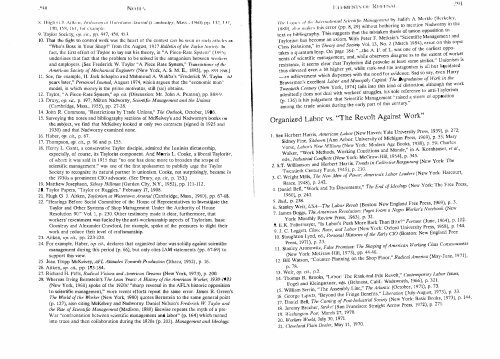CONTENTS - ouroboros ponderosa
CONTENTS - ouroboros ponderosa
CONTENTS - ouroboros ponderosa
You also want an ePaper? Increase the reach of your titles
YUMPU automatically turns print PDFs into web optimized ePapers that Google loves.
."lIl<br />
,'f 1111).',11 I i"L AiH,I'II. IIn'/"II.''''' ,1/ 1l;J/,'lf,,,.·,, .·In·,'u,,1 (I .lIlIloudl'.I·. r\b" .. 1"hOI PI' II' I".<br />
1·10. I S. 1 (. 1, fill' n;l!llp[(',<br />
9. Taylor Soci.:,ty, op. cit., pp. 447, ·1::l0, 1Yt<br />
10. ThaI the fight to control work was the hC:lrt of the contcsl (.;,111 bc Sl:CIl ill slJch :11 r j("k n_<br />
"Who's Boss in Your Shop?" rrom the August, 1917 Bulletin of the Taylor So,·i,·I)·. III<br />
fact, tl c first effort of Taylor to lay out his theory, in "A Piece-Rate Syskm" (IXII"q<br />
underlmes that fact that the problem to be solved is the antagonism between wOlkt.,'j<br />
and e . mployeT. [Sec Frederick W. Taylor " A Piece Rate System," Tram'aeli(m,v of" f/" .<br />
Ammean Soc-tery of Mechanical Engineers (New York, A. S. M. E., 1895), pp. S9r .'N,".]<br />
11. See, for example, H. Jack Schapiro and Mahmoud A. Wahba's "Frederick W. T:lyltll '"<br />
years later," Pe.rsonnel Journal, August 1974, which argues that the "economic man"<br />
model, in which money is the prime motivator, still (sic) obtains.<br />
12. Taylor, "A Piece-Rate System," op. eit. (Discussion: Mr. John A. Penton), pp. 88H.9.<br />
13. Drury, op. cit., p. 197; Milton Nadworny, Seiemific Management and the Unions<br />
(Cambridge, Mass., 1955), pp. 27-28.<br />
14. John . Commons, "Restrictions by Trade Unions," The OWlook, October, 1906.<br />
15. Surveymg the notes and bibliography sections of McKelvey's and Nadworny's books on<br />
the subject, we find that McKelvey looked at only two contracts (signed in 1925 ami<br />
1930) and that Nadworny examined none.<br />
16. Haber, op. cit., p. 67.<br />
17. Thompson, op . cit., p. 96 and p. 155.<br />
18. Henry Gantt, a conrvative Taylor disciple, admired the l..cninist dictatorship,<br />
especla!ly of course, Its Taylorist component. And Morris L. Cooke, a liberal Taylorit , {",<br />
Of . Whl It was said in 1915 that "no one has done more to broaden the scope of<br />
s,clehflc manage e t." was one of Ihe first spokesmen to publicly urge the Tilylor<br />
SoclCty to rccognze lts natural partner in unionism, Cooke, not surprisingly, became ill<br />
the 19305 a prominent CIO advocate. (See Drury, op. cit., p. 153.)<br />
19. Matthew Josephson, Sidney Hillman (Garden City, N.Y., 1952), pp, 111-112.<br />
20. Taylor Papers, "Taylor or Ruggles." February 17, 1908.<br />
21. . :lugh ? J. Aitken, l}lorism at . Watertown Arsenal (Cambridge, Mass., 1960), pp. 67-68.<br />
22 . -Ieanngs Before SOCial Committee of the House of Representatives to lnvestigste the<br />
faylor and Other Syslems of Shop Managemcnt Under the Authority of House<br />
Resolution 90," Vol. 1, p. 230. Other testimony made it clear, furthermore, that<br />
workers' re.o,;entmem was fueled by the anti-workmanship aspects of Taylorism. Isaac<br />
Goostray and Alexander Crawford, for example, spoke of the pressures to slight their<br />
work and reduce their level of craftsmanship.<br />
23. Aitken, op. cit., pp. 223-224.<br />
24. For example, Haber, op. cit., declares that organized labor was solidly against scientific<br />
managemet uring this period (p. 66), but only cites lAM statements (pp. 67-69) to<br />
support thiS vIew.<br />
25. Jean Trepp McKelvey, AFL Altiludes Towards Production (Ithaca, 1952), p. 16.<br />
26. Aitken, op . cit., pp. 183-184.<br />
27. Richard H. Pells, Radical Visions and American Dreams (New York, 1973), p. 200.<br />
28. Whers Erving Bernstein's The 1.ean Year.i: A History of the American Worker, 1920-1933<br />
(New York, 1960) spoke of the 1920s' "sharp reversal in the AFL's historic opposition<br />
to scientific management," more recent efforts repeat the same error. James R. Green's<br />
The World of the Worker (New York, 1980) quotes Bernstein to the same general point<br />
(p. 17), also citing McKelvey and Nadworny, Daniel Nelson's Frederick JY. Taylor and<br />
,<br />
the RISe of SCLentific Management (Madison, 1980) likewise repeats the myth of a pre<br />
'!lar "confrontation between scientific management and labor" (p. 164) which turned<br />
1I1to truce and then collaboration during the 1920s (p. 202). Management and Idl'.ology:<br />
nil' ,






